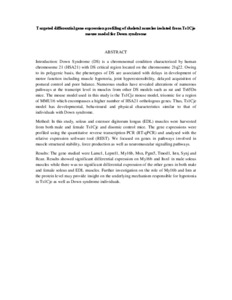Citation
Leong, Melody Pui Yee and Bala, Usman and Rosli, Rozita and Cheah, Pike See and Ling, King Hwa
(2015)
Targeted differential gene expression profiling of skeletal muscles isolated from Ts1Cje mouse model for Down syndrome.
In: 26th Annual Scientific Meeting of Malaysian Society of Neurosciences (MSN 2015), 5-7 June 2015, WEIL Hotel, Ipoh, Perak. (p. 40).
Abstract
Introduction: Down Syndrome (DS) is a chromosomal condition characterised by human chromosome 21 (HSA21) with DS critical region located on the chromosome 21q22. Owing to its polygenic basis, the phenotypes of DS are associated with delays in development of motor function including muscle hypotoria, joint hyperextensibility, delayed acquisition of postural control and poor balance. Numerous studies have revealed alterations of numerous pathways at the transcript level in muscles from other DS models such as rat and Ts65Dn mice. The mouse model used in this study is the Ts1Cje mouse model, trisomic for a region of MMU16 which encompasses a higher number of HSA21 orthologous genes. Thus, Ts1Cje model has developmental, behavioural and physical characteristics similar to that of individuals with Down syndrome.
Method: In this study, soleus and extensor digitorum longus (EDL) muscles were harvested from both male and female Ts1Cje and disomic control mice. The gene expressions were profiled using the quantitative reverse transcription PCR (RT-qPCR) and analysed with the relative expression software tool (REST). We focused on genes in pathways involved in muscle structural stability, force production as well as neuromuscular signalling pathways.
Results: The gene studied were Lamc1, Leprel1, My16b, Msn, Pgm5, Tmod1, Istn, Synj and Rcan. Results showed significant differential expression on My16b and Itsn1 in male soleus muscles while there was no significant differential expression of the other genes in both male and female soleus and EDL muscles. Further investigation on the role of My16b and Istn at the protein level may provide insight on the underlying mechanism responsible for hypotonia in Ts1Cje as well as Down syndrome individuals.
Download File
![[img]](http://psasir.upm.edu.my/75604/1.hassmallThumbnailVersion/Targeted%20differential%20gene%20expression%20profiling%20of%20skeletal%20muscles%20isolated%20from%20Ts1Cje%20mouse%20model%20for%20Down%20syndrome.pdf)  Preview |
|
Text (Abstract)
Targeted differential gene expression profiling of skeletal muscles isolated from Ts1Cje mouse model for Down syndrome.pdf
Download (37kB)
| Preview
|
|
Additional Metadata
Actions (login required)
 |
View Item |

